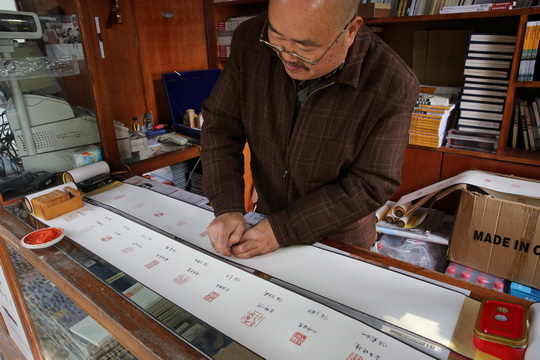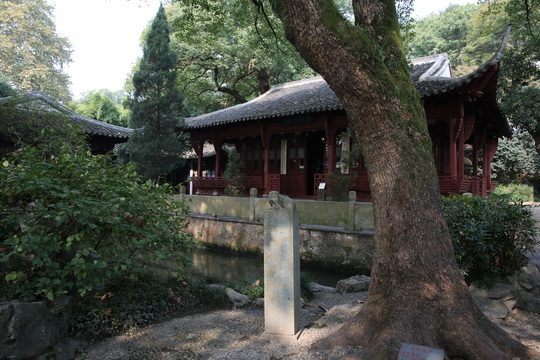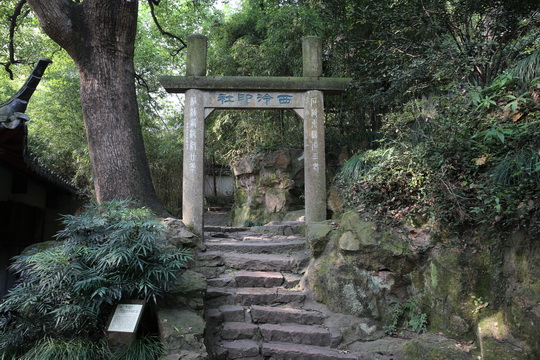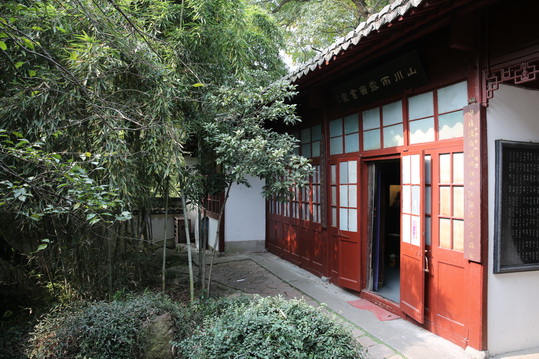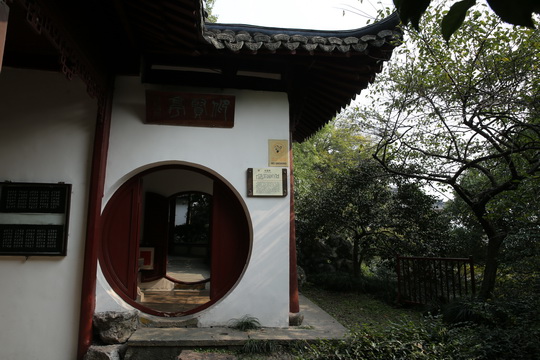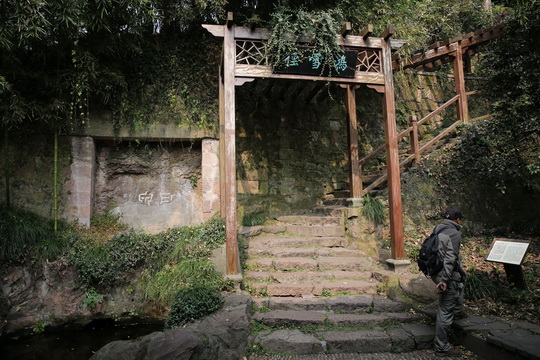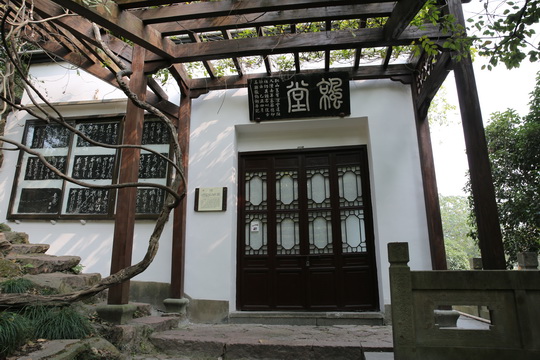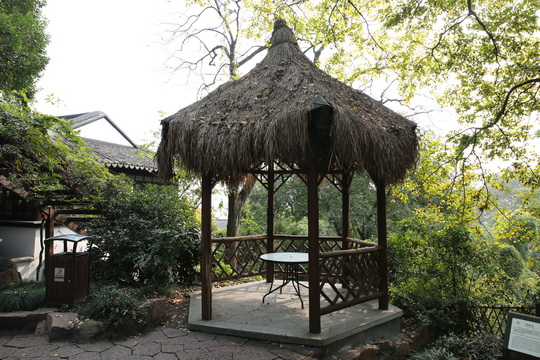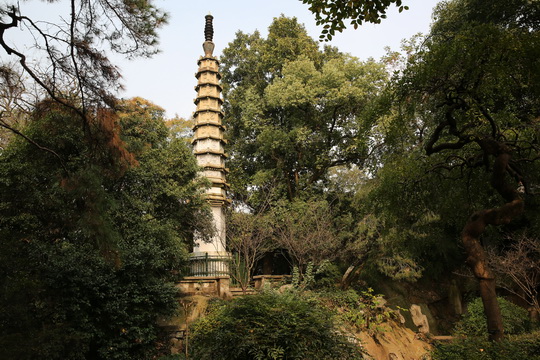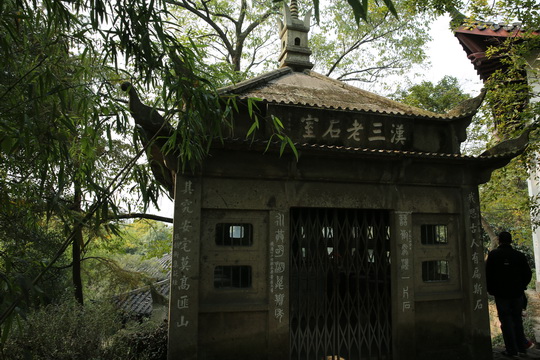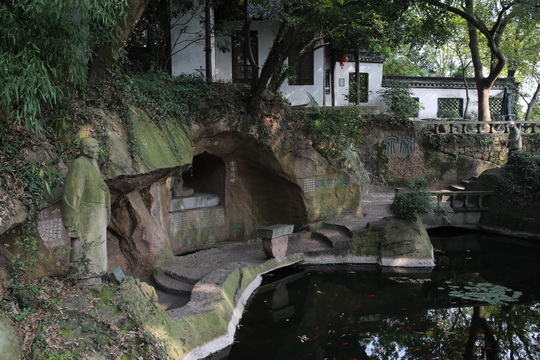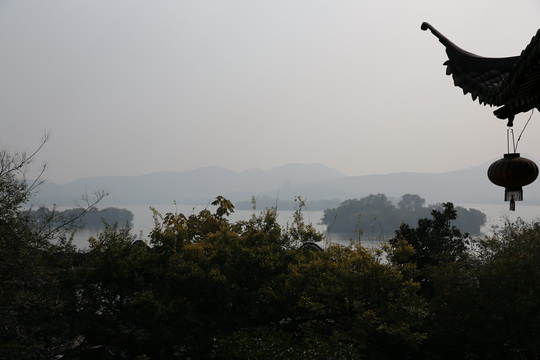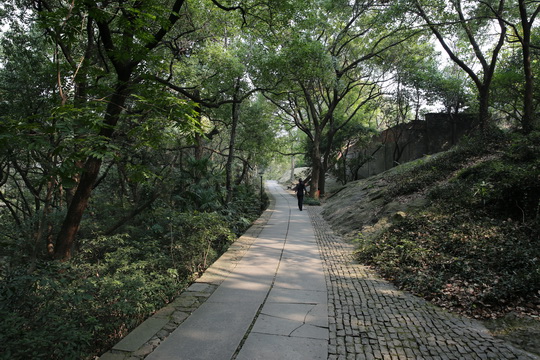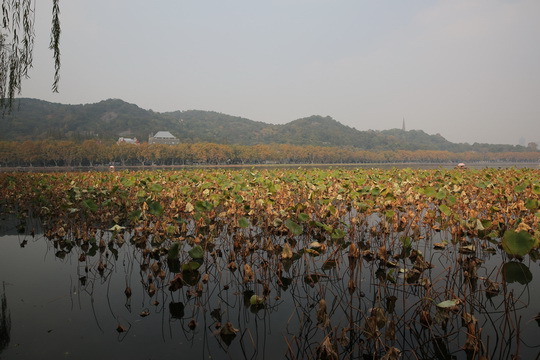Originally established in 1904, Xiling Seal Engravers’ Society (西泠印社), also know as Xiling Seal Art Society in Hangzhou is an association devoted to seal arts, the study of inscriptions on bronze and stones.
In 2009, Xiling Seal Seal Engravers’ Society was listed as World Intangible Cultural Heritage. If you are interested in Chinese traditional culture on your Hangzhou tour, Xiling Seal Engravers’ Society is an ideal place for 1-2 hour exploration.
Xiling Seal Art Society is located at the foot of the west side of Gushan Hill ( the Solitary Hill) in Hangzhou, extending to Bai Cause way linked to the east shore and to Xiling Bridge linked to the north shore. The society occupies an area of 7090 square meters with the 1750 square construction area.
Unlike the traditional layout, the structures of the society are scattered on the west side of Gushan Hill overlooking the West Lake. The major buildings including the Cypress Hall, the Bamboo Pavilion, Yangxian Pavilion, the terraces and Huayan Pagoda cascade the slope of the hill in good order, an excellent gardening landscape of Jiangnan ( the south Yangtze River Delta ).
Seal engraving (篆刻), is a unique art form of Chinese characters – Chinese characters engraved on bronze and stones. It originated in the formation of the Chinese characters in the Yin Dynasty (the later period of the Shang Dynasty, 16th-11th century BC) . The early forms of Chinese characters were engraved on animal bones or tortoise shells. Inscriptions on ancient bronze objects appeared in the Zhou Dynasty (1046 – 256BC). The stone engraving emerged in the mid-Spring and Autumn Period (770-476 BC).
Seals the later dynasties mostly were used as credence or keepsake, and for the collection and appreciation of paintings and calligraphic works. Great masters of seal engravings included Wen Peng, Ding Jing, He Zhen, Deng Shiru, Zhao Ziqian, Wu Changshuo, and Qi Baishi, etc.
Today seals ( “chops” in local colloquial English ) are still widely used instead of handwritten signatures to authenticate official documents or financial tranzactions. Chinese seal-engraving, the art of seal engraving has become more and more popular. Many foreign visitors are now able to appreciate the art form, uniquely Chinese.
Now follow me to visit Xiling Seal Engravers’ Society. Gushan Hill is only for pedestrians and cyclists. So you may bike or walk to Gushan Hill from the east shore ( starting from the Broken Birdge (断桥) or from the north shore at Xiling Bridge (西泠桥). Walk along the south side of the hill and soon you will see a moon gate with white wall and back tiles facing the West Lake – the entrance to Xiling Seal Engravers’ Society.
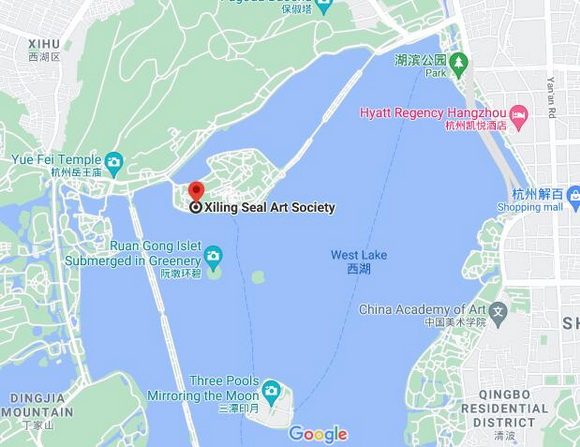
The entrance to Xiling Seal Engravers’ Society
By the gate, there is a kiosk where an old seal engraver is making the red ink on scrolls from seals (the carved names of the Top 10 West Lake Sights). For a few dollars, you are able to bring back home a souvenir of a scroll with seal red ink.
Making the red ink on scrolls from seals
Bai Hall ( Cypress Hall)
A few steps ahead, you see a traditional Chinese building – Bai Hall. Built in the Song Dynasty (960-1279) by the Monk Zhiquan, the hall derived its name from the two Bai Trees (Cypress) which stood at the front in the Chen Dynasty (557-589). The original building collaped long ago.
It was rebuilt in 1876, the second year of the Guangxu’s Reign, with a horizontal board inscribed by Yu Yue, a fmous scholar of the Qing Dynasty (1644-1911).
The present hall is designed to be used an exhibition hall for the history of the society. A TV is showing the documentary of the society.
The Stone Archway
Starting to climb up the hill through a stone archway on your left hand behind the Bai Hall. Set up in in 1923, the stone archway has a height of 3.3 meters and width of 2.19 meters. On the top of the archway there is the Chinese name of Xiling Seal Engravers’ Society, reading as “Xi Ling Yin She”, inscribed in semi-cursive script.
On each pillar of the archway inscribed with the verse of a couplet inscribed in seal characters, referring to the Stele of Sanlao regarding the Taboo Names and Dates of Death of the Han Dynasty collected in the society and the fact that the society had existed for 20 years. On the right cliff under the archway inscribed four Chinese characters redding as “Jian Ru Jia Jing”, which means “gradually entering blissful circumstances.
Shijiao Pavilion
Built in 1912, it is one of the early buildings of Xiling Seal Engravers’ Society. The name of Shijiao literally means “Making friends through mental and stones”.
Shanchuan Yulu Library
Built in 1912, it is also one of the early buildings of Xiling Seal Engravers’ Society, a place for members to comment on their seal works, discuss and exchange their views on the seal-cutting arts.
Yangxian Pavilion
Originally built in Ming Dynasty ( 1368-1644), it was rebuilt in 1905. It inherited the former name of “Yangxian” of Ming Dynasty which literally means “Admiring the nobles”. With green tiles and white walls, the enclosed pavilion was constructed in a simple and elegant form.
It houses the rich collection of cultural exhibits including the 28 portraits of masters in seal engraving and the full-length portrait of Ding Jing.
Hongxue Path, Yicang Rock and Yin Spring
Paved in 1913, Longxue Path was covered with an awning and Chinese wistaria was planted here. To the south, the top of the awning was carved with three Chinese characters “Hong Xue Jin” (Hong Xue Path) in regular script.
The name of Hong Xue Path is an allusion to a poem written by Su Dongpu, in which human life is likened to a swan’s footprints found on snow and mud.
The stone wall to the north of the path is set with a Taihu Rock, which is engraved with two characters “Yi Cang” cut in intaglio in small script. In 1918, Li Shutong had his personal belongings including some seals sealed in a niche here before he took the monk at Hupao Temple in Hangzhou at the age of 39. In the autumn of 1963, to celebrate the sixtieth anniversary of the founding of Xiling Seal Engravers’ Society, the stone niche was unsealed and 93 well-preserved seals were discovered.
Yi Spring is one of the four springs of the society. The place wad once the partition wall of the society. In 1911, the wall collapsed after it had been raining for a long time. A spring bubbled up here after the ground was dug. The Spring was named Yi Quan ( Yin Spring).
Liang Hall
Originally built in the Shaoxing’s Reign (1131-1162) of the Song Dynasty (960-1279), the hall once saw hundreds of plums planted before it and was regarded the most fantastic view at that time.
Unfortunately, the original hall decayed a long ago. Rebuilt 1924, the outer wall of the hall now has 9 stone carving with the inscription of Verse Prose on Xi Ma, written by Yue Fei, famous patriotic general of the Southern Song Dynasty ( 127-1279).
Tixian Pavilion
Continue to walk up the stone steps, on the hill top terrace, you will see a thatched pavilion – Tixian Pavilion, which literally means “Scraping the Mosses”, an allusion to the poem by Han Yu (768-907).
The verse of scraping the mosses refer to scraping the mosses to see the inscriptions, reminding us of the scene that the society members are studying hard on the ancient characters at Sizhao Pavilion nearby.
Avatamasaka Sutra Pagoda
On the hilltop, you will see the landmark of the society – Huayan Sutra Pagoda (Avatamasaka Sutra Pagoda). Built in 1924, the pagoda is a symbol of Xiling Seal Engravers’ Society. The octagonal pagoda stands on a Sumeru base with 11 stories. Each storey has an overhanging eave with a bell on the top. Buddha stautues are carved on the upper eight storeys, and Diamond Sutra is carved on the 9th and 10th storey below.
On the bottom of the pagoda, Avatamasaka Sutra, Note on Avatamasaka by Li Shutong, an outstanding Buddhist master and the names of the donaters for the construction of the pagoda as well as the portraits of the 18 arhats on the upper part of the bottom.
Han Sanlao Stone Chamber
On the west of the pagoda is a stone chamber named “Han Sanlao Stone Chamber”. Built in 1922, its construction is in the style of the Ashoka sharira stupa of the Wuyue Kingdom period (907-978) in its appearance. The stone chamber has multiple stone eaves and a pyramidal roof topped with a small Ashoka sharira stupa in unique shape and structure, which is of high value of architectural art.
The stone chamber houses the earliest existing stone tablets of the Han Dynasty in Zhejiang Province. The stone tablets are a collection of the Stele of Sanlao regarding the Taboo Names and Dates of Death as well as the stela and portraits from other dynasties.
Below the east side of Avatamasaka Sutra Pagoda is the pool and a hole connected to the other side of the hill. The famous engraver – Mr. Ding Jing’s statue stands by the pool.
The pavilion of Seal Engravers’ Club on the hill top overlooking the West Lake.
The Sizhao Pavilion on the top also has a panoramic view of the West lake.
Through the hole on the rock, you are able to walk to the path on the hill range from the east to the west. Walking on the path to the east direction, you are able to reach the edge of the Inner West Lake.
The autumn view of the Inner West Lake and Bai Causeway.
Tip: Hassle-free Hangzhou Guided Tours
If you don’t want to go the do-it-yourself route and prefer the hassle-free escorted tours, here are some options for Hangzhou Guided Tours:
Hangzhou Tour
Hangzhou 4-Day Tour Package
Hangzhou 3-Day Tour Package
Hangzhou Private Tour
Hangzhou Theme Tour
Hangzhou Side Trips
Hangzhou Car Rental with Driver
Further Readings
Top 10 Attractions in Hangzhou
Top 10 Photography Spots in Hangzhou
Night View of West Lake in Hangzhou
The Best hiking trail in Hangzhou
The best time to visit Hangzhou
Hangzhou as a Fashionable City in China
Hangzhou East Railway Station
Hangzhou Airport Arrival Hall
How to Visit Feilai Peak Grottoes in Hangzhou
Where to stay in Hangzhou
Hangzhou Bicycle Hire
Wushan Night Market in Hangzhou
Pedestrian Streets in Hangzhou
Hangzhou’s Best Bars & Nightclubs
Best Way to Visit Hangzhou from Shanghai
How to Visit Grand Canal Hangzhou
How to Visit Xiling Seal Engravers’ Society
How to Visit Liuhe Pagoda
Hangzhou Tea Plantation
How to Visit Leifeng Pagoda
How to visit Hupao Spring (Tiger Spring) Hangzhou
How to Visit Yellow Dragon Cave in Hangzhou
The Best Place to View Sunrise over West Lake Hangzhou
Any question, just drop a line.






